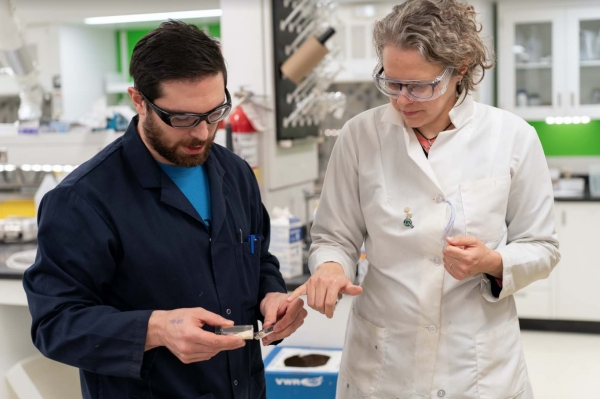While attempts to reduce plastic usage have taken many forms, including McGill’s plastic water bottle ban and much ado about straws, some McGill researchers are approaching the situation from a different angle, by replacing the controversial polymers with biodegradable alternatives. Audrey Moores, associate professor of applied chemistry and Thomos Di Nardo, a student in Moores’ lab discovered that plastic alternatives can be made out of a modified version of chitosan, which comes from a substance called chitin that is found in the shells of various crustaceans.
“With our method, we are able to transform chitin into chitosan, a well-known polymer used, among other things, for biomedical applications,” Moores said. “Because our method relies on making the chemistry happen under dry conditions, as opposed to in a liquid medium, we are able to make a chitosan with much larger molecular weight than what was previously known. This means, in short, that we made a brand new material […with] exciting properties, including better durability and robustness, so we can target novel applications with it.”
Most public campaigns on plastics emphasize reducing personal use or recycling more. Yet, while McGill’s campus and students tend to be a rather environmentally sensitive crowd—as evidenced by the increased appearance of glass containers and reusable mugs—it can be easy to get discouraged at the sheer volume of community-wide plastic consumption. Even climate change activists may falter in bringing their reusable straw from home on every spontaneous trip to the local cafe. However, these band-aid solutions aid progress toward the goal of moving away from plastic altogether.
Instead of just trying to reduce the sheer quantity of plastic used, replacing the material entirely might lead to greater success in phasing out ocean-littering plastics in the long term. The key is to have an environmentally-friendly replacement that is comparably efficient. This is part of what makes Moores’ discovery so critical.
Even if plastics could be eliminated entirely, they are so common that it would be impossible to maintain the current level of worldwide material wealth while doing so. Plastic is ideal for packaging because it is durable, lightweight, and very cheap. With suitable replacements, environmentally-friendly packaging might come to serve as a way for businesses to distinguish themselves from their competitors. Some examples include A&W introducing completely compostable bags and Starbucks vowing to replace their plastic straws with strawless lids or straws made of alternative materials by 2020. In both cases, a material was, or is being, engineered to take the place of plastic with miniscule, if any, change to customer behaviour. This makes the changes seem more viable for the long term both from an environmental perspective and from that of customer practicality.
Some of the future directions for research on the modified chitosan focuses on developing new applications of the material, such as for antibacterial fibres, and trying to source the chitin as sustainably as possible.
“Common plastics are sourced from petrochemicals, which have the advantage of being sourced in very large volumes from refineries,” Moore said. “Chitin sourced from crustacean shells is a different story because it is produced locally in so many different fisheries, harbors, and restaurants. So, we need a method of concentration of this raw material. We are partnering with companies in the Maritimes who have experience in this supply chain challenge [and] are currently working on targeting the best application based on these considerations.”









